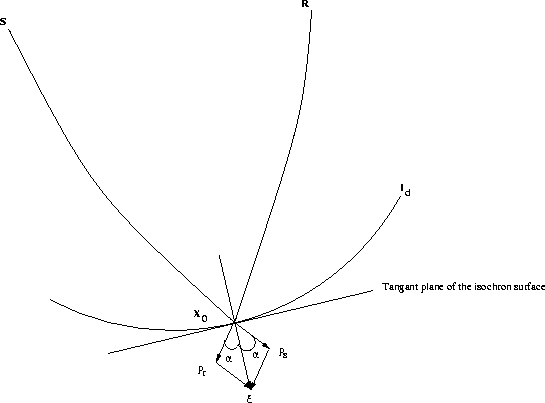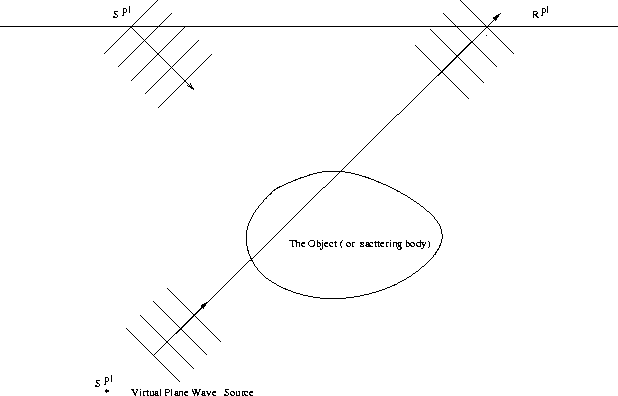




Next: (3) Least-squares migration/inversion
Up: (A) Non-iterative linearized migration/inversion
Previous: (1) Wave equation prestack
(a) Fourier Diffraction Tomography for constant background
Wu and Toksoz (1987) gave the plane-wave response in the direction  from an incident wave
from an incident wave  :
:
| ![\begin{displaymath}
P_{S}^{pl}\left(\vec{i}, \vec{r} \right) = -k^{2}\tilde{O}\left[k\left( \vec{r}-\vec{i}\right) \right]\end{displaymath}](img99.gif) |
(39) |
where ![$\tilde{O}\left[k\left( \vec{r}-\vec{i}\right) \right] $](img100.gif) is the 3D Fourier transform of the object function
is the 3D Fourier transform of the object function  .
.  is some kind of projection.
Comparing this to linear Radon transform, we know that the object function can be accurately restored if the angles of the plane waves continuously change around the object. Fig.3 shows the projection from the real plane wave source and from the virtual plane wave source.
is some kind of projection.
Comparing this to linear Radon transform, we know that the object function can be accurately restored if the angles of the plane waves continuously change around the object. Fig.3 shows the projection from the real plane wave source and from the virtual plane wave source.





(b) Inverse Generalized Radon Transform for variable background
The scattered wavefield after Bron and WKBJ approximation is of the following form:
| ![\begin{eqnarray}
P_{S}\left( \vec{r}, \vec{s},t \right)& = &-\frac{\partial^{2}}...
...ec{x}, \vec{s}\right)\right] f\left( \vec{x} \right) d^{3}\vec{x},\end{eqnarray}](img103.gif) |
|
| (40) |
where  and
and  .It is known that the diffraction-time surface
.It is known that the diffraction-time surface  in the data space is a counterpart of the isochron surface
in the data space is a counterpart of the isochron surface  in the model space. These dual geometric associations naturally give rise to a corresponding pair of projection operators.
Equation (40) can be written as
in the model space. These dual geometric associations naturally give rise to a corresponding pair of projection operators.
Equation (40) can be written as
|  |
(41) |
The diffraction curve in the data space is a projection of an isochron in the model space. This is a kind of Radon transform Hubral et al. (1996); Miller et al. (1987).
The standard Radon transform and inverse Radon transform in three dimensions are given by
|  |
(42) |
and
| ![\begin{displaymath}
f\left(\vec{x}_{0}\right)=-\frac{1}{8\pi^{2}} \int \left[ \f...
...\right) \vert _{p=\vec{\xi} \cdot \vec{x}_{0}}\right] d^{2} \xi\end{displaymath}](img110.gif) |
(43) |
respectively, where p is the distance from the origin to a plane which cuts through the object body,  is the unity direction vector which is normal to the plane, and
is the unity direction vector which is normal to the plane, and  is a point on the plane.
is a point on the plane.
GRT_fig
Figure 4 The geometry between the incident and scattering rays near the scattering point, or imaging point  . .
|
|  |





Comparing this with the classical Radon transform and its inverse, the final 3D inversion formula can be given as
|  |
(44) |
In equation (44), the angle variable  near the imaging point
near the imaging point  is used, rather than the measurement configuration at the surface. Fig.4 illustrates this. The angle variable is related to the measurement configuration and reflects the seismic wave illumination aperture. Only if the aperture is large can a high resolution image be obtained. The relative true-amplitude imaging is severely affected by the angle variable. Bleistein and Stockwell (2001); Zhang (2004) gave some similar true-amplitude migration/inversion formulas.
is used, rather than the measurement configuration at the surface. Fig.4 illustrates this. The angle variable is related to the measurement configuration and reflects the seismic wave illumination aperture. Only if the aperture is large can a high resolution image be obtained. The relative true-amplitude imaging is severely affected by the angle variable. Bleistein and Stockwell (2001); Zhang (2004) gave some similar true-amplitude migration/inversion formulas.





Next: (3) Least-squares migration/inversion
Up: (A) Non-iterative linearized migration/inversion
Previous: (1) Wave equation prestack
Stanford Exploration Project
11/1/2005

![\begin{eqnarray}
P_{S}\left( \vec{r}, \vec{s},t \right)& = &-\frac{\partial^{2}}...
...ec{x}, \vec{s}\right)\right] f\left( \vec{x} \right) d^{3}\vec{x},\end{eqnarray}](img103.gif)
